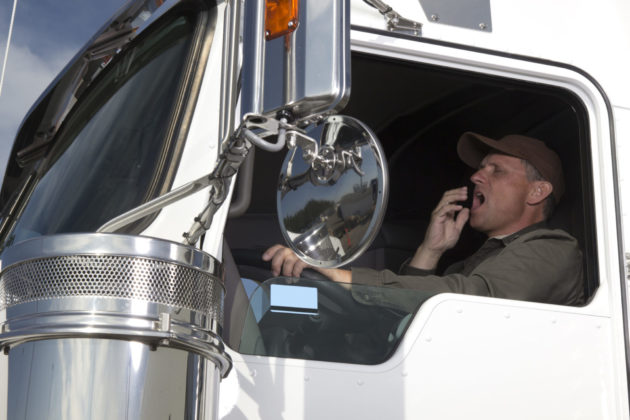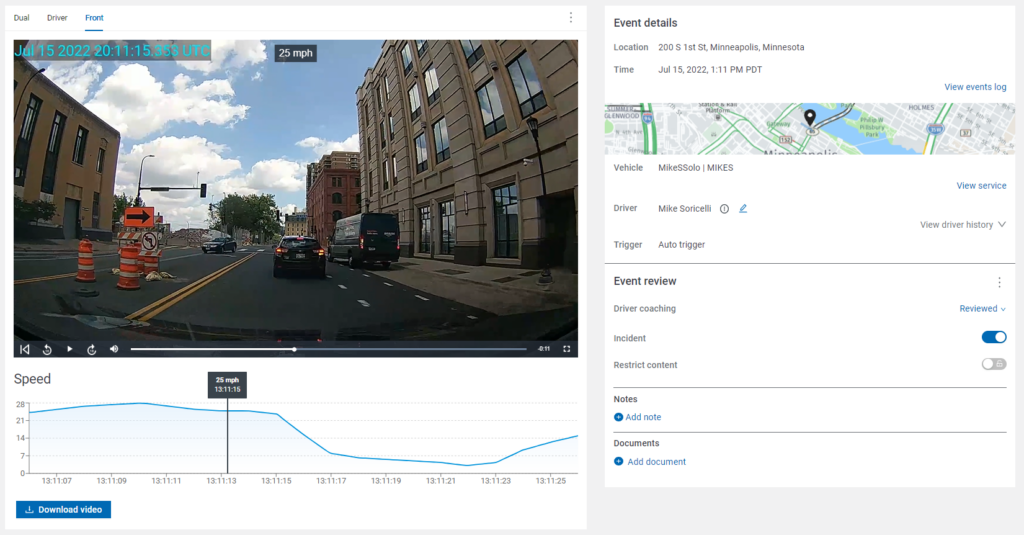Video will reveal the good, the bad, and the ugly of driver performance
A fleet that decides to roll out an in-cab video program should be prepared to see the good, the bad, and the ugly as it analyzes footage captured by the devices. And sometimes – if a stubborn driver resists the presence of the camera and obstructs its view – maybe even nothing at all.
TruckNews.com asked several experts with experience viewing in-cab video footage how they’d react to several scenarios.
That driver looks tired
In-cab video can shine a light on the potential for a fatigue-related crash before it even happens. If a driver is yawning, drifting within their lane, or their eyelids are closing, these are obvious signs of fatigue that may only be discovered with help of a driver-facing camera.

“We contact the driver ASAP and start a discussion,” Tom Boehler, senior director of safety and compliance with Erb Group, says of any video that shows those telltale signs of fatigue. Erb will look at what the root causes of the fatigue could be. “We review our driver fatigue program with the driver and the resources available to correct or combat fatigue. One of the most common issues of a night round-trip [driver] is the quality of sleep they can get during the day at home, particularly if there are young children at home during the day.”
Erb also looks at scheduling to see if load planning can be improved on its end, so loads are ready when drivers are ready to work.
Jim Angel, vice-president – video telematics with ERoad, suggests looking for patterns.
“It’s important to review other videos of this same driver to see if this behavior has been repeated in other clips, showing a potential driving habit,” he says. “From there, you are then able to discuss this occurrence or occurrences with the driver to figure out if this is a result of fatigue or if there’s a larger root to the problem.”
Third-party witness
Spend enough time on the road and it’s bound to happen to any professional driver. They’re driving along, minding their own business, and a wreck they didn’t cause occurs right in front of their rig. They activate the camera to record what transpires next – and with many of today’s cameras, also what happened in the seconds leading up to the device being manually activated.
While a trucker’s instinct is to get on with the delivery, that captured footage could be invaluable to law enforcement or those involved in the crash.
“We have provided video to authorities,” says Boehler. He recalls a crash on I-94 in Michigan, in which a motorist crossed three lanes before crashing into a disabled school bus on the shoulder, killing a tow truck driver who was working on the bus. “Our driver hit the Record Incident button, knowing it goes back eight seconds, and pulled over at the scene. Michigan State troopers sent a thank-you email to us and the driver as it saved a lot of investigation time.”
Erb will also share footage with other carriers if their vehicles are recorded doing something noteworthy. And Kriska Transportation Group has, on more than one occasion, shared crash video with law enforcement. In one case a driver captured video of a sportscar running a GMC Suburban off the road and seriously injuring its driver.
“It had nothing to do with our truck at all,” says Guy Broderick, Kriska’s safety and training supervisor. “When we sent the video to the officer his comment to me was, ‘Wow, we had a totally different description of the car that was involved.’”
Drivers at Kriska are instructed to leave the company’s number with the first responders so they can follow up with any video requests, which are supplied by the safety department.
ERoad’s Angel adds: “It’s very important to preserve any and all video information, decide as a company when to share this information, and communicate with your driver that they were not at fault and how they did a great job at avoiding the crash.”

Nothing to see here
In-cab video is triggered by a harsh event. But when the video is reviewed, it shows nothing more than a black screen. A seasoned, longtime driver finds the camera intrusive and has taken the liberty of covering it while driving.
“Policy pertains to everyone,” says Boehler, noting Erb lost just three drivers out of more than 800 when it deployed cameras. When concerns are raised, he says, “We review his or her concerns and why we brought the system in place – primarily for their protection, the protection of the company, and to identify any situation that could help the driver avoid bad habits.”
Broderick was an early adopter of in-cab video, and in those early days he saw every attempt imaginable to circumvent the technology. “Everything from chewing gum, Post-It notes, Band-Aids,” he rhymes off. “The best one was we had a driver cut a piece of electrical tape that fit perfectly over the lens.”
The system Broderick relies on today will detect and report tampering. And Kriska hasn’t had any such issues. “We have it written right in our performance and safety program, if you cover that camera there are repercussions,” Broderick says.
When rolling out a video program, Boehler suggests extending communication to drivers’ families and spending time in the driver’s room to quickly dispel any rumors about the purpose behind the technology. ERoad’s Angel says resistance to in-cab video is waning.
“Today, most drivers understand the reasoning and benefits that come with having these cameras inside their trucks to show that they are professionals on the road,” he says. “When it comes to accidents, staged or otherwise, 75-80% of the time the other vehicle is at fault in catastrophic car/truck accidents. It remains important for carriers to explain to drivers that without these cameras there are more opportunities for someone to falsely say they were at fault and how these videos can exonerate a driver from any false claims.”
Uh-oh. That’s our fault.
The worst type of video you can receive is one that shows your driver was at fault in a crash. Or is it? Having video of the incident is preferrable to having no video at all, regardless of who’s to blame, according to Heather Devine, a longtime transportation lawyer who has represented many trucking clients over the years before recently becoming chief legal counsel of 3PL firm Traffix.
“As legal counsel to many excellent carriers over my 20-plus years, in the event a fleet captures video showing it’s at fault in a crash, I would prefer my client to have the footage,” she says.
“We always want the video. Always. It’s a training video, right off the bat.”
Guy Broderick, Kriska
“When key evidence does not exist, it leads to a gray area of uncertainty and, in turn, can require extensive legal work to get to a resolution from documentary and oral discoveries, written undertakings, pre-trial motions, pre-trial mediation, and then trial. Unclear evidence can lead to a win where a case is dismissed; however, it also provides a situation where a plaintiff can increase the claims for damages since causation is not clearly defined nor delineated. Having evidence that is clear – in addition to witness statements, telematics readouts, accident recreations – can assist good counsel to resolve a matter efficiently and economically.”
While it may come as no surprise that a lawyer would want video evidence of an incident, wouldn’t a fleet wish such footage didn’t exist? Maybe even second guess their decision to install the cameras in the first place?
“We always want the video. Always,” insists Broderick. “It’s a training video, right off the bat.”
Videos of incidents – good and bad – are shown by Kriska at orientation. And drivers better relate to footage showing their own company trucks rather than generic videos sourced from YouTube. “Every critical event is a training event,” Broderick adds.
Back in the courtroom, video of the event – however damning it may look – can benefit a fleet through a quicker settlement (maybe even made confidentially, avoiding public admissions of guilt).
Erb’s Boehler said the company retains all video pertaining to claims, using it as part of its post-collision investigation and also for training purposes. Legally, he says, “It helps us determine the extent of liability and the need to mitigate the claim ASAP.”
When an at-fault crash does happen, Mark Napier, director of safety services with Tandet Group, says it can be beneficial to review video from well before the point of impact.
“They normally give you 30 seconds, which isn’t enough to show us exactly what happened,” he says of in-cab video. “I want to see the 30 minutes prior. We will then spend time looking at things like, were the driver’s mirrors adjusted properly? Were the hood mirrors on the truck installed and adjusted properly? Did we have a vision problem that either contributed to [the problem], or didn’t help us?”
Something to celebrate
Any safety manager’s favorite footage to review will be that showing their driver doing something heroic or exceptional. These can be the impetus for rewards and recognition and shouldn’t go unheralded. Erb’s camera program generates certificates for drivers seen making an alert maneuver to prevent a crash.
That footage is, with the driver’s permission, also shared in safety meetings. Sometimes it’s even shown on the TVs in the drivers’ room. Using in-cab video footage to celebrate good driving, not just to punish bad, will help extinguish any remaining skepticism among drivers about the intent of the program.
“When a driver makes a safe maneuver on the road to prevent a crash, we believe that is well worth promoting that driver within the company,” Angel adds.
Have your say
This is a moderated forum. Comments will no longer be published unless they are accompanied by a first and last name and a verifiable email address. (Today's Trucking will not publish or share the email address.) Profane language and content deemed to be libelous, racist, or threatening in nature will not be published under any circumstances.
@Larry Hall … What exactly is “professionalism”? As a 41 year veteran, I am sure many readers would be keen to learn your definition of a professional driver.
A very long article focusing only on the driver. It’s a pity that no one talks about, for example, the mandatory introduction of cameras recording what’s happening around the truck while driving on the road !!!!!! In my opinion, if the driver could see on the screen what was happening around his car 360 degrees, it would improve road safety more than recording the driver yawning!!!!!!
With every advance in technology, the trucking industry takes another step further away from professionalism and competence behind the wheel. I can certainly understand why a large fleet would need some of these tools to monitor and manage so many employees however, I’ve been around the industry long enough to see the nuclear fallout of “technological advancements” and how they have effected the overall caliber behind the wheel.
In my short career (41 years) we have gone from drivers that were respected by other motorist, to drivers which are despised by them. The demand for truck drivers outstrips the availability and ergo – grab any warm body throw them behind the wheel and technology will keep us all safe right(?)
So incredibly obvious that this path does more damage than good.
The driver turnover rate exceeds 100%, is the an app to fix that?